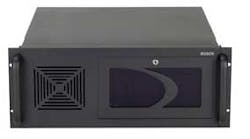Q: Eight months ago we put in an outdoor megapixel camera security video system, and were getting more than 30 days of storage. Now we’re down to 10 days—but we haven’t changed any of the camera or system settings. How can this be?
A: It is likely that trees and other greenery are the culprits affecting the rate of motion-based recording.
Whenever motion-based or other analytic-based recording is used, it is important to remember that the recording is based upon conditions in the target environment, and if the target environment changes—so can the amount of recording. That is what happened in this case—the greenery grew outside the camera field of view areas that were being excluded from motion detection.
Motion-Based Recording
When motion-based recording is set up, motion masking is often used. Rectangular or polygonal areas of the image are marked for exclusion, so that motion in those areas will not trigger recording. However, over time the trees or shrubbery grow and can extend beyond masked areas in camera views.
Detecting Motion
Most video-based motion detection is based upon the amount of pixel change in an area of the image. Depending on the sensitivity setting, when enough pixels change, it’s considered motion. So things that we don’t normally think of as moving objects can trigger recording—like slightly overgrown grass or the dark shadow of a cloud passing over a sidewalk.
Quarterly inspection of video cameras with motion detection settings or video management systems using server-based motion analytics is recommended to see if their cameras’ fields of view have changed. Seasonal changes in cloud patterns, the growth of vegetation beyond motion-exclusion mask areas, and changes to facility lighting can all impact recording patterns. To avoid problems, such sources of “motion” should be identified and appropriate compensation applied.
Some Motion Sources Can’t Be Masked
Some sources of continuous or recurring motion at the far end of a camera’s field of view can’t be masked without also masking out areas closer to the camera, where the intended target objects or people are found. Sometimes this can be remedied by moving the location of the camera, but not always. Sometimes other means of motion detection, such as dual-technology PIR/microwave motion detection technology can be applied effectively, connecting the detector output signals to the camera alarm input contacts to trigger recording. It can take a bit of study and field testing to identify all the motion-detection factors involved, and to get things working optimally.
Calculating Storage Requirements
Most video system vendors provide storage calculators that use a percentage factor for the amount of time the camera will actually be recording. Scheduled recording is a fixed factor that is easy to take into account, as 12 hours of recording each day is 50 percent. When motion-based recording is involved—don’t just take a wild guess.
Is there is high motion as employees arrive and depart for work? Add up the rush hour times (start of business hours, lunchtime, and end of business hours) and consider them as 100 percent motion. Add two more hours of 100 percent recording for sunrise and sunset, as during those times shadows and lighting level changes can be interpreted as motion by the camera. If trees are in the picture—will the wind blow around the leaves on the ground during the fall? How many days of rain or snow will there be? Factor those in as well. It can require a little bit of math before you have the numbers that are right to enter into the storage calculator.
Configuring Motion Detection
Besides taking motion into account when figuring storage requirements, it should also be considered in setting up motion-detection for each camera. For example, it is not necessarily a safe assumption that greenery will always be trimmed back to match the camera motion exclusion masks. Where feasible, vegetation motion masks should be designed to accept a season’s worth of vegetation growth, something that may be discernible from earlier video recordings or site photographs, or by talking to the facilities or real estate folks who maintain the greenery. During rainy times grass-cutting can be curtailed, and so it may be prudent to consider taller grass levels when setting the sensitivity for gassy areas in windy environments.
A little more thought than is typically given to motion-based recording can make a significant difference in how well the system will meet its video storage retention period requirements.
Write to Ray about this column at [email protected]. Ray Bernard, PSP, CHS-III is the principal consultant for Ray Bernard Consulting Services (RBCS), a firm that provides security consulting services for public and private facilities. For more information about Ray Bernard and RBCS go to www.go-rbcs.com or call 949-831-6788. Mr. Bernard is also a member of the Content Expert Faculty of the Security Executive Council (www.SecurityExecutiveCouncil.com). Follow Ray on Twitter: @RayBernardRBCS



